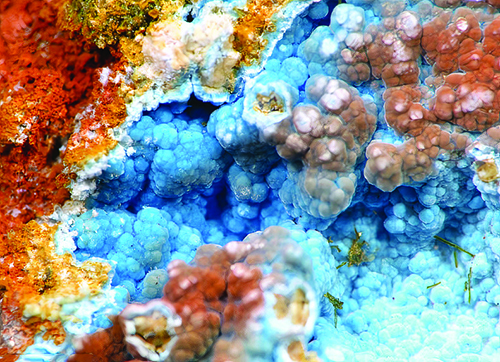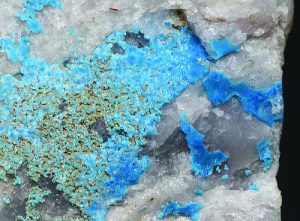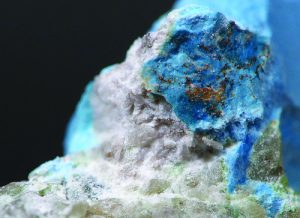

Editor’s Note: This article, written by Bob Jones, originally appeared in the August 1976 issue of Rock & Gem.
I sure like blue gems, especially copper gems. Living in Arizona makes me prejudiced, I guess. I’ve always been attracted to azurite, malachite, chrysocolla, and turquoise in any and all polished forms!
Recently, Bruce Alsup, from Wenden, Arizona, showed me a “new” copper gem, and it’s a beauty. He calls it ceruleite, and I had to dash to my copy of “The Dana” to look it up. I’d never heard of it. Sure enough, it’s a valid species and is a heck of a beautiful blue gem.

Ceruleite is a hydrated arsenate of copper and aluminum that occurs in massive-appearing aggregates of rod-like crystals not unlike massive compact malachite. The aggregates show no crystallization, being so compact as to be a solid mass suitable for cutting and polishing. The results are excellent, offering an attractive alternative to turquoise and chrysocolla.
Ceruleite is aptly named, for the word cerulean means “azure,” not the azure blue of azurite but the blue of a marvelous spring sky. Found in abundance, it would be an immediate best seller in the gem market today, competing favorably with turquoise. It is, however, very rare, and the gem market will not feel its impact under present conditions of production. There is, of course, considerable interest in it among collectors of rare gems. Surely for the lapidary looking for something different and attractive, ceruleite will offer a fine change from the common copper gems.
The properties of ceruleite don’t present any major problems or hazards to the lapidary. It works a lot like turquoise, so some care must be taken, “gentle and cool” being the watch words for working the material. It cuts easily and holds a polish well, having a hardness of about 6. Polishing is best accomplished using a piece of soft felt and Zam for the pre-polishing. This should be followed by a piece of muslin and Zam for the final polish.

The type locality for ceruleite is an old gold mine near Huanaca, Chile, a country rich in common and rare copper minerals. This latest find, however, comes from somewhere in Southern Bolivia. The early Chilean find occurred around the turn of the 20th century. This newest find is only a couple years old [in 1976, that was]. Around 25 pounds or so has been brought to the surface so far. This will, of course, cut into a heck of a lot of fine gem material, but the lapidary market of today [mid-1970s] could absorb hundreds of pounds very easily if the material were available, for its fine color is enough to make it a big seller.
Let us hope that whatever the cause of a limited supply, it will improve, and that we can look forward to an increase in the availability of this gorgeous blue copper gem ceruleite.
Author: Bob Jones
 Holds the Carnegie Mineralogical Award, is a member of the Rockhound Hall of Fame, and has been writing for Rock & Gem since its inception. He lectures about minerals, and has written several books and video scripts.
Holds the Carnegie Mineralogical Award, is a member of the Rockhound Hall of Fame, and has been writing for Rock & Gem since its inception. He lectures about minerals, and has written several books and video scripts.
If you enjoyed what you’ve read here we invite you to consider signing up for the FREE Rock & Gem weekly newsletter. Learn more>>>
In addition, we invite you to consider subscribing to Rock & Gem magazine. The cost for a one-year U.S. subscription (12 issues) is $29.95. Learn more >>>
















